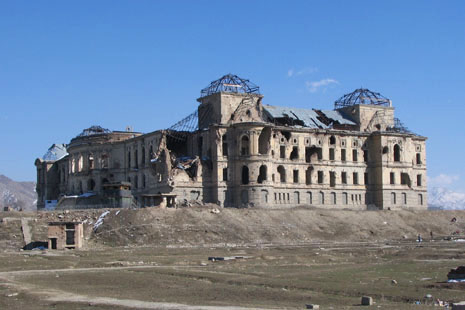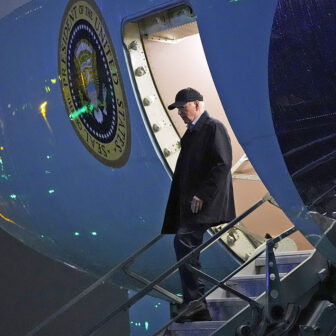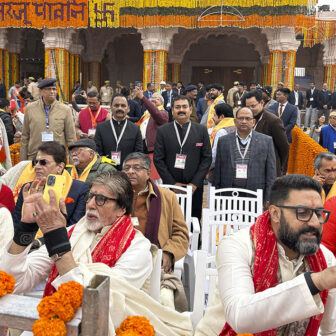THE RUINS of Kabul’s Darul Aman Palace stand as stark testimony to the conflicts that have torn Afghanistan apart over the past fifty years. Built in the 1920s by King Amanullah Khan, the Palace reflected a desire to westernise and modernise the country along democratic principles. But it has been gutted by fire, and bombed and shelled as part of communist uprisings and civil war. More recently the Palace, which occupies an imposing position on the southern edge of Kabul city, has been used as an observation post by NATO troops.
Like plans to restore the Palace as a home for the national parliament, which appear to have stalled due to a lack of foreign investment, Afghanistan itself stands at the crossroads. In one direction lies a country based on democratic institutions, support and a steadily developing economy. In the other direction lies a return to the past, with conflict based on religious ideology and ethnic divisions. Are Afghanistan’s democratic institutions strong enough to support the first alternative, a transition to a more free and tolerant society?
The fragility of Afghan democracy can be observed in the attitudes of Afghans. The Asia Foundation has been conducting public opinion surveys of the Afghan people over the past four years, and their latest results show declining confidence in the efficacy of elections (down from 75 per cent in 2006 to 52 per cent in 2008). The survey also found declining tolerance for alternative political views, with two-thirds of people opposed to the idea that all parties should be able to hold local meetings, presumably preferring that only parties with local support should be allowed to have meetings. While 40 per cent say they feel free to express their political views, almost the same number (39 per cent) believe they do not have that freedom due to fears for their own safety, security concerns or a Taliban presence. These results underscore the difficulty of establishing democracy in the current environment of conflict and violence that is evident across the country.
Ethnicity remains the most significant factor in Afghan politics, and the strongest determinant of how people will vote. At around 40 per cent of the population, the Pashtun are the largest ethnic group, though they do not constitute a majority. The Tajiks constitute about 30 per cent of the population, and the Hazara and Uzbeks about 10 per cent each. Several other ethnic groups, including the Aimak, Turkmen and Baluchi, make up the remainder.
The importance of ethnicity was borne out in the 2004 presidential elections, with Hamid Karzai, a Pashtun, securing the vast majority of his ethnic group’s support, and picking up votes from other ethnic groups largely because of his high profile as the transitional president prior to the election. Incumbency played a significant role.
With the next presidential election due to be held on 20 August this year, the successful candidate will need to secure a good proportion of the Pashtun vote to win. Pashtun candidates with a high profile, including Karzai, Anwar Ahadi (the finance minister) and Gul Agha Sherzai (a former jihad leader who worked with the US invasion team in 2001 but is now willing to negotiate with the Taliban), are well-placed to do this.
There are at least two possible Tajik candidates who could cross the ethnic divide to win the election. Abdullah Abdullah, a senior Tajik leader from the north-east province of Panshir, has a Pashtun father, and has been actively promoting this fact to gain Pashtun support. Yunus Qanuni, another Tajik leader, came second in the 2004 election (with 16 per cent), but was subsequently elected to parliament. His election as Speaker has increased his profile among non-Tajik groups. The final list of presidential candidates is due to be announced in May.
Unfortunately, Afghanistan has been burdened by an electoral system for its national assembly (the Wolesi Jirga) which is inappropriate for most democracies, let alone a fledgling democracy struggling to heal the divisions of the recent past. The country uses the Single Non-Transferable Vote, or SNTV, system – best described as first-past-the-post for multi-member electorates – for provincial and national elections. Voters make one selection only. If the election is for five members, the five highest-polling candidates are elected.
Along with Jordan, Taiwan, Vanuatu and Pitcairn Island, Afghanistan is one of the few places in the world that uses SNTV. Electorates are formed by the boundaries of the thirty-four provinces, with seats distributed in proportion to the total population. This means that seat magnitude ranges from three seats in the smaller provinces to thirty-three seats in the most populated province, Kabul. A third of provinces elect ten or more members.
The absurdity of the system is highlighted by the results for Kabul province in the 2005 election. With 390 candidates competing for thirty-three seats, the ballot paper took up seven A3-sized sheets. As a result, there was a high rate of informal voting and many intending voters are reported to have discarded their ballot papers because of the difficulty in finding their preferred candidate.
When the transitional administration was deciding on an electoral system in 2004, prior to the country’s first elections, it seemed likely that a form of proportional representation would be adopted, with advisors warning against first-past-the-post or SNTV systems. According to electoral expert Andrew Reynolds, one of Karzai’s advisors was unable to give Cabinet a clear explanation of the proposed proportional representation system. This allowed opponents to argue that if the system could not be understood by Cabinet ministers it was unsuitable for the general population. According to Reynolds, SNTV was chosen as the “least bad” option.
One argument in support of SNTV was that it is simple. Voters need to make just one choice, so there’s no need for them to understand party lists or to number multiple boxes. This was an important consideration in a country with low literacy levels. But the large number of MPs representing many provinces, and therefore the large fields of candidates, negate this intended simplicity. Among other SNTV democracies, the largest electorate is only seven members.
The voting system also means that many candidates are elected with very low voter support. The leading candidate in Kabul received only 13.8 per cent of the vote, and twenty-three of the thirty-three elected members received less than one per cent. SNTV also weakens the party system by placing the emphasis on individual candidates. Without any party lists or recognition of parties on the ballot paper, there is no incentive for candidates to affiliate with parties. In fact, there remains a strong suspicion and distrust of political parties, as many of the older parties were military organisations during the civil war or were connected to the previous communist governments. In addition, President Karzai has been vocally opposed to political parties, blaming them for many of the ethnic divisions within the country.
Despite this distrust, registering political parties is a growth industry in Afghanistan. More than 100 parties are registered with the Ministry of Justice (ideally, an independent authority should be in charge of registering parties) and about twenty to twenty-five parties claim to have MPs in the Wolesi Jirga. Some of these MPs declared their party affiliation prior to the 2005 election, but many have been recruited into a party, or have switched allegiances, since the election. While parties tend to overstate how many representatives they have, MPs themselves often distance themselves from any party connection, seeing an advantage in being viewed as independent. As a result, the Wolesi Jirga operates as an assembly of 249 individuals with shifting alliances. (To be precise, 239 individuals, because ten members have been killed since the last election – another indication of the ongoing threats to democracy in the country.)
Most of the major parties have strong ethnic bases and advocate on behalf of their ethnic base in order to muster continued support. Many were former jihad parties that fought the Soviet occupation and then turned on each other during the civil war. While they may have demobilised their military operations, they have maintained military-like organisational structures, which have been useful in recruiting armies of volunteers and getting out the vote.
Since 2001, a new generation of multi-ethnic, democracy-based parties has emerged. Because their support base is hard to identify and their leaders tend to have a low-profile, these parties have had difficulty in gaining traction. Their organisational structures and financial resources mean that they find it difficult to match the older parties in campaigning.
In an effort to reduce the number of parties, it has been proposed that the current minimum membership requirement of 700 members to register a party be increased to 10,000 members. While this change might simplify Afghanistan’s party system, it will not necessarily improve it. There would remain no incentive for parties to be promoted at election time, and the emphasis on leaders and individual candidates – during elections and within parliament – would continue.
It has also been suggested that parties should be required to have a national presence, with a certain number of members in a majority of provinces. This, it’s argued, would reduce the current emphasis on geographically based parties with distinct ethnic platforms and encourage a shift to multi-ethnic parties with the national interest at heart. Ethnic tensions would be diffused rather than accentuated during election campaigns, and parties would be forced to differentiate themselves via their policy platforms.
WHILE MUCH of this may (and should) sound like a pessimistic view of Afghan democracy, there are positives to note. Western influence during the transition to democracy has resulted in a requirement that a quarter of the Wolesi Jirga seats (sixty-eight of 249) be reserved for women, a significant breakthrough for an Islamic country. Although some women MPs appear to be mouthpieces for their male political guardians, there are several strong, independent women in the Wolesi Jirga providing a growing voice for women’s rights in the country.
But Afghanistan’s democratic institutions will need to change significantly if the country is to survive as a functioning democracy. A form of proportional representation, or a mix of proportional and individual seats, should be introduced so that there is a greater connection between voters’ choices and election outcomes. Proportional representation would also provide greater legitimacy to election results, in contrast to lottery-style SNTV which allows candidates to be elected with 0.4 per cent of the vote. If SNTV is to be retained, the size of electorates should be reduced to avoid the large numbers currently elected from some provinces. Kabul province, for example, could be divided into seven electorates of five members each.
A move to proportional representation would also strengthen the party system by requiring groupings of party candidates. The party system should be further strengthened by adopting rules of parliamentary conduct that recognise parties. Although this may be culturally difficult in Afghanistan, which has a history of consensus decision-making, it would smooth the way for the management of business and debate in the Wolesi Jirga chamber. Other changes to party law, such as introducing public funding and giving an independent registrar the power to audit party finances, would help to level the playing field between parties.
The problem with all of these proposals is that with the current electoral and party systems in place, the winners and losers know who they are. For meaningful reform to occur, the current winners will have to act unselfishly by giving up some of their power for the good of the country. It is difficult to be confident of such an outcome.
Today, the Darul Aman Palace’s prospects mirror that of democracy in Afghanistan. There’s great potential, but the unstable structure needs urgent renovation to avoid complete collapse. •




